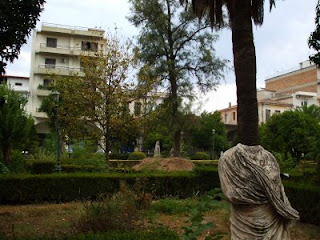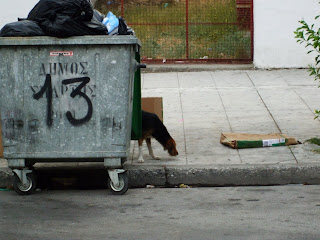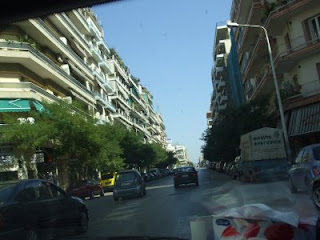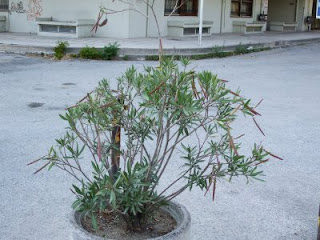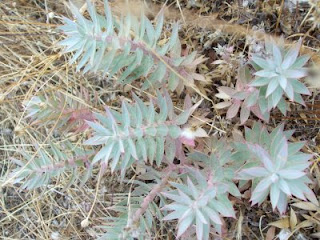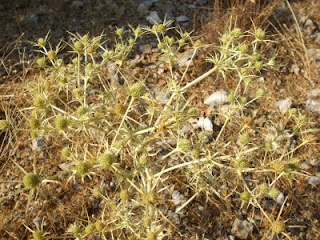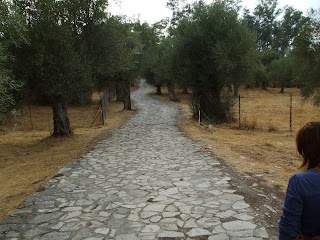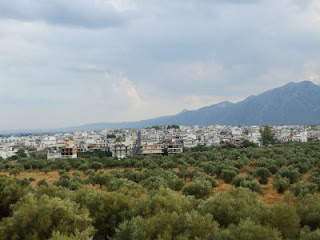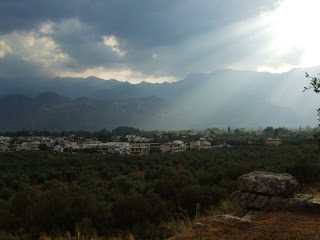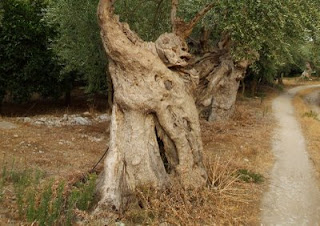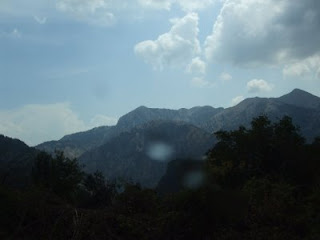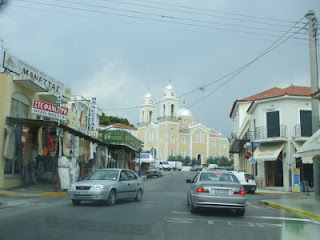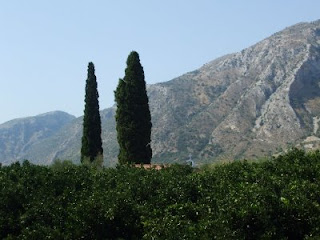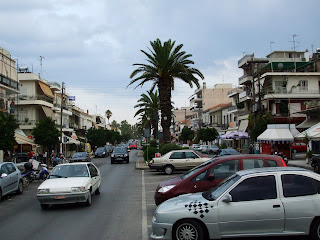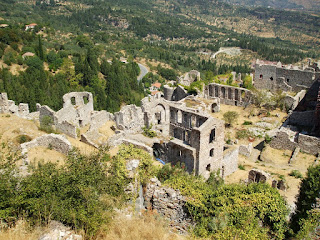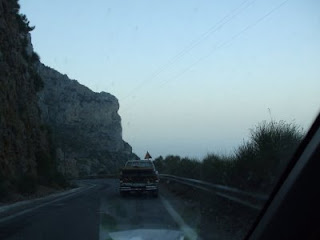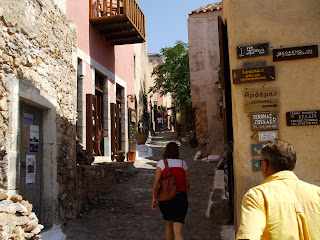How to lose weight [Solved]
In this day and age, being or getting fat is treated like a drug addiction, in all sense of the word treated. Fat people are marginalised, socially pushed to find a solution. Many solutions are provided, from pills that help you lose weight to food replacement things and "health food" so that they can slowly get rid of this addiction to food. And in many respects, fat people are behaving like addicts. They have cravings, they find reasons for eating "just a little bite", they show withdrawal symptoms, they try quitting and they fail. There are also "pushers", trying their best to hook you on chips, sugary drinks, fatty meats and fast foods as well as food suplements and slim drinks.
The funny thing is that the actual solution to extra weight is the same as in the case of hard drugs: you want to get rid of heroin addiction, stop taking heroin. There is this slightly annoying fact that you can live without heroin, but you can't without food. But there are people working on it.
Anyway, I started writing this because, as far as I am concerned, I know I have found the solution. And it is not so hard to do it, either. I've started from 116kg, lost 16 in 4 months, started drinking Coca-Cola like crazy while keeping the diet, didn't gain much weight, then started eating a lot of pasty, bready, pizzy and fatty food and gained 10 kg in about 1 month and a bit, then I started a custom (less strict) diet again and got to 104kg in 1 month. In other words, even if I stop the diet, I have to make an effort to gain weight. Even if I slip a little, it doesn't matter. And if I make my own food style, one that avoids too much fat and bread and sugar, I don't gain weight, even if I stop the diet completely. It is way easier to gain weight than to lose it, but that is not the point.
Bit by bit, though.
You have to consider that this is not a weight loss blog and that I am only describing my experience here, but hey, it worked. From what I could gather there are three points that need covering:
In order to not gain extra weight, eat less. A normal sedentary human needs about 2000 calories per day. We eat a lot more than that and a lot of it just goes out in the toilet. A small part (but significant to this blog entry) is stored as fat. By eating 1500 calories you get to stop gaining weight and start losing it. But how does one know what 1500 calories mean? Very simple: you get a list of what you are supposed to eat every day at every meal and you don't stray from it.
In order to maintain your weight even after stopping the diet, you need to eat the right stuff. I don't know exactly what that means, but guessing by the food I am allowed to eat and what I am not and what I Googled on the net, I found out that there is a separation of food types into alkaline and acidic foods. Supposedly, you need 75% of the first category and 25% of the latter. A normal Western diet is the other way around, hence the weight gain and the accumulation of fat. Also, the division of foods in these two categories seems to have nothing to do with pH, as lemons are considered highly alkaline. Probably the terms refer to the body's response to them. Also, you need to stay off carbo-hydrates. This is called a "low-carb" diet. Carbo-hydrates is a fancy word for sugars, but there is the good sort (like in fruits and a bit honey) and the bad sort (like refined sugar and refined flour products).
And last, but not least, eat many times a day. That is counter intuitive, but if you think about it, it makes a lot of sense. The human body is very adaptive. If you eat once a day, it will remember to shut off functions that use energy the rest of the day. Not to mention that you'll probably get an ulcer anyway. So instead of losing weight, you will lose energy. Even worse, when you start eating again, the body will just store it, since it is running in energy-saving mode. Instead, if you eat many times a day, your body knows energy is freely available and the metabolic rate will go up instead of down, helping you to burn reserves (fat).
Ok, enough theory. I will give you a general 1500 calory diet to follow every (fucking) day. If you get bored, read the part about the routine. Don't stop. Remember, I lost 16 kilos in 4 months and then I had to make an effort to put 10 kilos back.
So, there are 5 meals a day! breakfast, brunch, lunch, lupper (sorry, couldn't help it :) ), supper. You are allowed to drink water and green tea with no sugar only. Maybe coffee in the morning, but that's frowned upon :D.
Breakfast (7:00-8:00): 100g of low fat meat (like grilled chicken breast, fish, cremwurst (the thing in the hot dog), etc.) and/or low fat cheese (like mozarella or any low fat cheese). 100g in total. That means like 3 (slim) cremwurst sausages. Also a tomato and a cucumber (a normal cucumber, like the ones that are the total size of a tomato :) not the huge ones). You are allowed two slices of bread, not white, but wheat bread.
Brunch (10:00-11:00): 250g of fruit. Any fruit. Or 4-5 dried fruits.
Lunch (13:00-14:00): 150g of low fat meat (preferably grilled, else you start dreaming of warm meals) and a salad (tomato salad, green salad, boiled vegetables whatever. Use olive oil and as little salt as possible. Use lemon juice, not winegar). For example if you want to make yourself a tomato salad, you use 2 tomatos and a cucumber, some olive oil and lemon juice and a little salt. That's the size of a salad, not 4 kilos of tomatoes with mayo salad dressing. Two slices of wheat bread.
Meal between lunch and supper (16:00): 250g of fruit. Any fruit. Or 4-5 dried fruits.
Supper (18:30-19:30): 400g of yoghurt and/or low fat meat or salad. 400g in total, use at least 200g of yoghurt, though, it has enzimes that will help you during the night. Maybe replace the yoghurt with a less fatty soup. One slice of wheat bread.
That is it! You eat nothing else. You drink nothing else than water and grean tea. You avoid sugar as much as possible, onions and carrots and peas are sweet, too. No diet drinks or sugar-free chewing gum, they don't really help. Chocolate is a no no. Icecream is a crime. Alcohol deserves capital punishment. (well at least that's what the nutritionist told me).
My opinion of it? Well, things are not so bad. Remember that you cannot put more weight than what you eat. Even if you live by breathing air and you store everything you ingurgitate, you cannot gain 10 kilos if you only eat 1. Does your body store the Coca Cola drink you crave? No. But it uses that sugary goodness as energy and stores anything else you eat. Will you inflate like a balloon if you go to someone's birthday party and you eat a little cake and drink some champagne? Not really, unless people start looking at you funny while you are the only one eating the cake and there is not much left. This doesn't apply if you go to birthday parties every day!
And, remember, this is for a person that makes no physical effort whatsoever other than getting up each morning and going to work. Riding your bike at work or jogging or doing physical exercises will make this go even faster. They don't have to be difficult or complex. Finding your food in restaurants or shops is difficult, therefore you should prepare your lunch at home. That might look strange, to carry your own food, but weigh it (pun intended) against the purpose of your diet and the benefits of not being fat.
The thing is that after you reach your desired weight, you still have to keep up with this kind of eating. It keeps you fit. You can eat normal food, go to restaurants, drink sugary drinks and alcohol, but remember to balance it with the diet you just went through. Sugar and alcohol is somewhat like a really unhealthy fruit, fat is like a lot of meat, not eating vegetables is just not good. Your body is the result of evolution working on people who ate mostly plants and sometimes a little meat. Consider that when you order your double cheese hamburger and a diet Coke. Anyway, speaking of diet soft drinks, it doesn't really work. Drink the regular ones (unless you like the taste of the diet ones) just don't overdo it. It's the same with the food. Eat it rationally, even if you like to eat.
I felt no real feeling of hunger during this diet. The 5 meals a day thing keeps you full of energy and always with something in your stomach. You might feel hungry in the evening and then, if you reeeeeally find it hard to resist, drink a small glass of milk. Not regularly, just when you are really hungry. The milk makes your hunger go away, but also keep your body from losing weight.
The Routine
Well, you noticed it. The whole diet is based on daily routine. It might drive you crazy for a while, but consider that you have been doing it anyway. You wake up in the morning, wash, piss, drink the ritual coffee or whatever, get dressed, go to work, do the same thing you do every fucking day, return home and watch TV or spend "quality time" with the wife or play some silly game on the computer or even work part jobs. Then you go to sleep. It's a routine.
All you need to do is alter it a little to suit your needs.
People worst than you have done it. People incarcerated and tortured every day found solace in the real life inside their heads while living the reality in a state of trance brought on by routine. Routine is the basis of one's comfort. You only explore when you leave your comfort zone. You can do it "in your free time", if this mythical thing even exists, or just in your head, while your body is running the automated program you set up. Now I am not really talking about losing weight here, I am going general. The thing that keeps everyone content and not going crazy is not the quality of life, but the routine of it. We train ourselves to function in the given conditions.
Talking about drugs you cannot not talk about Trainspotting. The film that old people took as a drug promoting movie while for all the people that actually watched it, it was a powerful anti-drug statement. There is this part of the movie where Renton tries to quit heroin and he just hates his life. It's not because of the withdrawal symptomps, but because of the sheer boredom of it. When something that defines your pleasure is taken away, when the excitement is gone, your life feels like a slow death. It's easy to just go back to the pleasure you know. Even if it is just as boring, it feels good. But routine is what saves your ass.
The same applies to food. You dream of all the possible combinations of taste and texture and what you would do if you weren't on the diet. You don't feel hungry, you see, you don't need food, you need the pleasure of it. You want to fuck that food with your mouth and make it cum saliva. But it's all fake. When you slip and try to eat that food you realise that the fat you craved makes you feel sick, the food you want may be not on the diet sheet, but you can just about make it with those ingredients. You don't need junk food to eat good. And that is what this is all about after all. You get healthier by adjusting some parameters, not by losing something. Even if you can't lose all the weight you wanted, who gives a damn if you are still a little fat? You are a healthy fat guy! Not a morbidly obese piece of blubber that just waits miserably for their coronary.
So stick to the routine. Experiment with food while keeping to the principles of the diet when you get out of it. Stay in the comfort zone and leave it for short periods of time when you feel good about yourself. Choose your next stage of development and get to it when you feel like it.
Now I sound like those people trying to sell you stuff. I wanted to write this for a long time, mostly because I had to explain all of this to a lot of people over and over again. Now I have this post, you can read it here. I guess the bottom line is that your body as well as your brain is always in training mode. Whenever you do something that feels good, you train it to want more, whenever you do something that feels bad, you train it to want less. So it is your responsability, after all, to choose the things that make you feel good.
The funny thing is that the actual solution to extra weight is the same as in the case of hard drugs: you want to get rid of heroin addiction, stop taking heroin. There is this slightly annoying fact that you can live without heroin, but you can't without food. But there are people working on it.
Anyway, I started writing this because, as far as I am concerned, I know I have found the solution. And it is not so hard to do it, either. I've started from 116kg, lost 16 in 4 months, started drinking Coca-Cola like crazy while keeping the diet, didn't gain much weight, then started eating a lot of pasty, bready, pizzy and fatty food and gained 10 kg in about 1 month and a bit, then I started a custom (less strict) diet again and got to 104kg in 1 month. In other words, even if I stop the diet, I have to make an effort to gain weight. Even if I slip a little, it doesn't matter. And if I make my own food style, one that avoids too much fat and bread and sugar, I don't gain weight, even if I stop the diet completely. It is way easier to gain weight than to lose it, but that is not the point.
Bit by bit, though.
You have to consider that this is not a weight loss blog and that I am only describing my experience here, but hey, it worked. From what I could gather there are three points that need covering:
- Don't gain extra weight
- Eat the right stuff to maintain your weight
- Keep your metabolism running to lose weight
In order to not gain extra weight, eat less. A normal sedentary human needs about 2000 calories per day. We eat a lot more than that and a lot of it just goes out in the toilet. A small part (but significant to this blog entry) is stored as fat. By eating 1500 calories you get to stop gaining weight and start losing it. But how does one know what 1500 calories mean? Very simple: you get a list of what you are supposed to eat every day at every meal and you don't stray from it.
In order to maintain your weight even after stopping the diet, you need to eat the right stuff. I don't know exactly what that means, but guessing by the food I am allowed to eat and what I am not and what I Googled on the net, I found out that there is a separation of food types into alkaline and acidic foods. Supposedly, you need 75% of the first category and 25% of the latter. A normal Western diet is the other way around, hence the weight gain and the accumulation of fat. Also, the division of foods in these two categories seems to have nothing to do with pH, as lemons are considered highly alkaline. Probably the terms refer to the body's response to them. Also, you need to stay off carbo-hydrates. This is called a "low-carb" diet. Carbo-hydrates is a fancy word for sugars, but there is the good sort (like in fruits and a bit honey) and the bad sort (like refined sugar and refined flour products).
And last, but not least, eat many times a day. That is counter intuitive, but if you think about it, it makes a lot of sense. The human body is very adaptive. If you eat once a day, it will remember to shut off functions that use energy the rest of the day. Not to mention that you'll probably get an ulcer anyway. So instead of losing weight, you will lose energy. Even worse, when you start eating again, the body will just store it, since it is running in energy-saving mode. Instead, if you eat many times a day, your body knows energy is freely available and the metabolic rate will go up instead of down, helping you to burn reserves (fat).
Ok, enough theory. I will give you a general 1500 calory diet to follow every (fucking) day. If you get bored, read the part about the routine. Don't stop. Remember, I lost 16 kilos in 4 months and then I had to make an effort to put 10 kilos back.
So, there are 5 meals a day! breakfast, brunch, lunch, lupper (sorry, couldn't help it :) ), supper. You are allowed to drink water and green tea with no sugar only. Maybe coffee in the morning, but that's frowned upon :D.
Breakfast (7:00-8:00): 100g of low fat meat (like grilled chicken breast, fish, cremwurst (the thing in the hot dog), etc.) and/or low fat cheese (like mozarella or any low fat cheese). 100g in total. That means like 3 (slim) cremwurst sausages. Also a tomato and a cucumber (a normal cucumber, like the ones that are the total size of a tomato :) not the huge ones). You are allowed two slices of bread, not white, but wheat bread.
Brunch (10:00-11:00): 250g of fruit. Any fruit. Or 4-5 dried fruits.
Lunch (13:00-14:00): 150g of low fat meat (preferably grilled, else you start dreaming of warm meals) and a salad (tomato salad, green salad, boiled vegetables whatever. Use olive oil and as little salt as possible. Use lemon juice, not winegar). For example if you want to make yourself a tomato salad, you use 2 tomatos and a cucumber, some olive oil and lemon juice and a little salt. That's the size of a salad, not 4 kilos of tomatoes with mayo salad dressing. Two slices of wheat bread.
Meal between lunch and supper (16:00): 250g of fruit. Any fruit. Or 4-5 dried fruits.
Supper (18:30-19:30): 400g of yoghurt and/or low fat meat or salad. 400g in total, use at least 200g of yoghurt, though, it has enzimes that will help you during the night. Maybe replace the yoghurt with a less fatty soup. One slice of wheat bread.
That is it! You eat nothing else. You drink nothing else than water and grean tea. You avoid sugar as much as possible, onions and carrots and peas are sweet, too. No diet drinks or sugar-free chewing gum, they don't really help. Chocolate is a no no. Icecream is a crime. Alcohol deserves capital punishment. (well at least that's what the nutritionist told me).
My opinion of it? Well, things are not so bad. Remember that you cannot put more weight than what you eat. Even if you live by breathing air and you store everything you ingurgitate, you cannot gain 10 kilos if you only eat 1. Does your body store the Coca Cola drink you crave? No. But it uses that sugary goodness as energy and stores anything else you eat. Will you inflate like a balloon if you go to someone's birthday party and you eat a little cake and drink some champagne? Not really, unless people start looking at you funny while you are the only one eating the cake and there is not much left. This doesn't apply if you go to birthday parties every day!
And, remember, this is for a person that makes no physical effort whatsoever other than getting up each morning and going to work. Riding your bike at work or jogging or doing physical exercises will make this go even faster. They don't have to be difficult or complex. Finding your food in restaurants or shops is difficult, therefore you should prepare your lunch at home. That might look strange, to carry your own food, but weigh it (pun intended) against the purpose of your diet and the benefits of not being fat.
The thing is that after you reach your desired weight, you still have to keep up with this kind of eating. It keeps you fit. You can eat normal food, go to restaurants, drink sugary drinks and alcohol, but remember to balance it with the diet you just went through. Sugar and alcohol is somewhat like a really unhealthy fruit, fat is like a lot of meat, not eating vegetables is just not good. Your body is the result of evolution working on people who ate mostly plants and sometimes a little meat. Consider that when you order your double cheese hamburger and a diet Coke. Anyway, speaking of diet soft drinks, it doesn't really work. Drink the regular ones (unless you like the taste of the diet ones) just don't overdo it. It's the same with the food. Eat it rationally, even if you like to eat.
I felt no real feeling of hunger during this diet. The 5 meals a day thing keeps you full of energy and always with something in your stomach. You might feel hungry in the evening and then, if you reeeeeally find it hard to resist, drink a small glass of milk. Not regularly, just when you are really hungry. The milk makes your hunger go away, but also keep your body from losing weight.
The Routine
Well, you noticed it. The whole diet is based on daily routine. It might drive you crazy for a while, but consider that you have been doing it anyway. You wake up in the morning, wash, piss, drink the ritual coffee or whatever, get dressed, go to work, do the same thing you do every fucking day, return home and watch TV or spend "quality time" with the wife or play some silly game on the computer or even work part jobs. Then you go to sleep. It's a routine.
All you need to do is alter it a little to suit your needs.
People worst than you have done it. People incarcerated and tortured every day found solace in the real life inside their heads while living the reality in a state of trance brought on by routine. Routine is the basis of one's comfort. You only explore when you leave your comfort zone. You can do it "in your free time", if this mythical thing even exists, or just in your head, while your body is running the automated program you set up. Now I am not really talking about losing weight here, I am going general. The thing that keeps everyone content and not going crazy is not the quality of life, but the routine of it. We train ourselves to function in the given conditions.
Talking about drugs you cannot not talk about Trainspotting. The film that old people took as a drug promoting movie while for all the people that actually watched it, it was a powerful anti-drug statement. There is this part of the movie where Renton tries to quit heroin and he just hates his life. It's not because of the withdrawal symptomps, but because of the sheer boredom of it. When something that defines your pleasure is taken away, when the excitement is gone, your life feels like a slow death. It's easy to just go back to the pleasure you know. Even if it is just as boring, it feels good. But routine is what saves your ass.
The same applies to food. You dream of all the possible combinations of taste and texture and what you would do if you weren't on the diet. You don't feel hungry, you see, you don't need food, you need the pleasure of it. You want to fuck that food with your mouth and make it cum saliva. But it's all fake. When you slip and try to eat that food you realise that the fat you craved makes you feel sick, the food you want may be not on the diet sheet, but you can just about make it with those ingredients. You don't need junk food to eat good. And that is what this is all about after all. You get healthier by adjusting some parameters, not by losing something. Even if you can't lose all the weight you wanted, who gives a damn if you are still a little fat? You are a healthy fat guy! Not a morbidly obese piece of blubber that just waits miserably for their coronary.
So stick to the routine. Experiment with food while keeping to the principles of the diet when you get out of it. Stay in the comfort zone and leave it for short periods of time when you feel good about yourself. Choose your next stage of development and get to it when you feel like it.
Now I sound like those people trying to sell you stuff. I wanted to write this for a long time, mostly because I had to explain all of this to a lot of people over and over again. Now I have this post, you can read it here. I guess the bottom line is that your body as well as your brain is always in training mode. Whenever you do something that feels good, you train it to want more, whenever you do something that feels bad, you train it to want less. So it is your responsability, after all, to choose the things that make you feel good.


